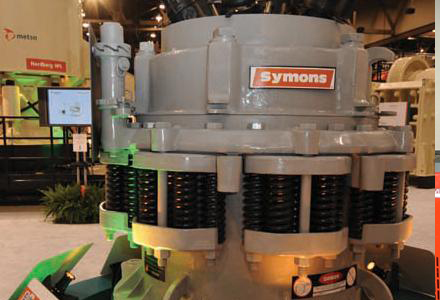
Cone crushers are now accepted technology but in the 1920s the Symons Brothers innovation was an unknown quantity, although an enduring one with some original units still in use. Claire Symes reports
Until six months ago the machine was part of a 500tonnes per hour plant at the John S Lane Quarry in Springfield, Massachusetts, US and is still in full working order. The unit was only replaced because the operator wanted to increase production at the limestone quarry and the 910mm head, 150tonnes per hour cone has been replaced by a new HP400 unit.
Before introduction of the cone crusher, aggregate processing was generally undertaken using a jaw or roll crusher or an Allis Chalmers gyratory crusher. The development of the cone crusher helped to improve the quality of the aggregate produced.
The Nordberg unit is based on the design concept from the Symons Brothers, which was manufactured in the US by Finnish-born Bruno Nordberg in Milwaukee from 1926. Nordberg started out building regulators for steam driven engines and also collaborated with Rudolf Diesel on the development of engines for power plants, ships and submarines. He also owned the Rex Works business that still builds concrete batch plants and conveyor parts.
Symons sold 250 units in the first year and, after the design was copied they believed the cone crusher market to be saturated, they sold the design rights to Nordberg in 1927. Nordberg was acquired by Rauma Repola in 1990 and the company later changed its name to Metso in 2001.
Nordberg went on to sell numerous more units and the popularity and durability of the design also meant that the parts for the Symons units proved to be very lucrative. "Nordberg, and later Metso, has now sold over 25,000 cone crushers worldwide and there are a number of units from the 1920s and 1930s still in use," said Metso applications engineer John Googins.
While the operation of the 1934 unit is conceptually the same as the modern cone crushers, the crusher does not have the same level of safety or maintenance easing features which are now taken for granted.
The standard 1934 unit has a 3ft (991mm) head with a 40 degree angle and can take 6inch (150mm) feed material to give a maximum output of 150 to 200tonnes per hour. The crusher was also available as a short head version, which was used for tertiary crushing to process finer material with a feed intake size of 3inches (75mm).
The 170horsepower (126kW) unit uses an oil pump to drive the gear assembly rather than direct drive to give the head a speed of 500rpm with 60% of the feed passing the closed side setting. Metso's latest HP5 cone crusher operates at 1000rpm with 80% passing the closed side setting.
"The higher speed is critical to achieving cubicity of the crushed aggregates," said Googins. "While the 1934 machine was still functioning well, newer models offer significant improvements in both safety and maintenance."
Modern cone crushers have hydraulic adjustment to aid clearance of blockages and uncrushable materials but the original Symons design had coil springs with just 50mm of play. "Non-crushable objects had to be cleared by hand which could be very dangerous if the blockage suddenly cleared," said Googins. "The crusher could be adjusted using a windlass to loosen the bolts but took two men around 30minutes to complete. Modern hydraulics give clearances of 125mm and are automatically controlled taking seconds to activate and return the crusher to operation." Despite the basic safety design and labour intensive maintenance, the Symons concept was one of Metso's longest running production models with units on sale for several decades. The Symons product line was joined by gyratory crusher in 1946 and the Gyrodisc in 1954, but a new style cone crusher - the Omnicone - was introduced in 1981 and later replaced by the HP cone crusher range in 1990.













